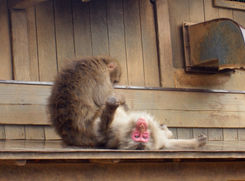
Iwatayama Monkey Park
Encyclopedia

Park
A park is a protected area, in its natural or semi-natural state, or planted, and set aside for human recreation and enjoyment, or for the protection of wildlife or natural habitats. It may consist of rocks, soil, water, flora and fauna and grass areas. Many parks are legally protected by...
located in Arashiyama
Arashiyama
is a district on the western outskirts of Kyoto, Japan. It also refers to the mountain across the Ōi River, which forms a backdrop to the district.Notable tourist sites in Arashiyama include...
in Kyoto
Kyoto
is a city in the central part of the island of Honshū, Japan. It has a population close to 1.5 million. Formerly the imperial capital of Japan, it is now the capital of Kyoto Prefecture, as well as a major part of the Osaka-Kobe-Kyoto metropolitan area.-History:...
, Japan
Japan
Japan is an island nation in East Asia. Located in the Pacific Ocean, it lies to the east of the Sea of Japan, China, North Korea, South Korea and Russia, stretching from the Sea of Okhotsk in the north to the East China Sea and Taiwan in the south...
. The park is on Mt Arashiyama, on the same side of the Oi River
Katsura River
The is a continuation of two other rivers, the Hozu River, a small, speedy river which begins in the mountains near Kameoka and then slithers through the mountains separating Kameoka and Kyoto; and the Ōi River , which emerges from those mountains and expands into a shallow, slow-flowing river...
as the train station. It is inhabited by a troop of over 170 Japanese macaque
Japanese Macaque
The Japanese macaque , historically known as saru , but now known as Nihonzaru to distinguish it from other primates, is a terrestrial Old World monkey species native to Japan....
monkeys. The animals are wild but can be fed food purchased at the site.
Getting there
The nearest train station is Arashiyama, which is a private line, travelers using the JR pass will arrive at JR Saga Arashiyama which is a bit further away.The entrance to the park itself is to the right after crossing the second bridge.
After you have used the bilingual (Japanese/English) vending machine to buy your tickets you face a steep climb up the mountain. After walking up approx 150 steps, the trail forks. Walking up the left hand side is a steeper but faster set of switchbacks for your trip to the top, going to the right will bring you around the back towards the children's park before reaching the top on a shallower slope. Total hike time should take approximately 30 minutes.
The park itself
Once you reach the top, the attendants show you into a hut with wire fence covering the windows, here you can buy drinks for yourself, and food to give to the monkeys.The choice of food for the monkeys ranges from bags of apple and banana slices, bags of biscuits, and bags of chestnuts and peanuts. As of July 2011, bags of food are sold for JPY 100.
The monkeys hang onto the outside of the wire fences and reach inside to get the food.
Be careful when feeding the monkeys as they snatch the food from you hands very quickly which may scare some small children, also you have to be careful that they don't take the whole bag from you.
Facilities
At the top there are drinks available as well as Japanese-style toilets, and a children's playground.There is also a Japanese toilet at the start of the climb up the mountain.
There are three sets of viewing platforms to get a good view of the city below you.
Park rules
Don't stare the monkeys in the eye: Many monkeys consider this a sign of aggression and may get scared or return the aggression.Don't touch the monkeys: As the monkeys are wild animals, they may have parasites or illness you could catch, try to avoid touching them at all and if you do touch them wash your hands thoroughly straight away.
Don't feed them outside: This encourages them to misbehave.
Iwatayama Monkey Park in media
The park is featured in an episode of the Japanese animatedAnime
is the Japanese abbreviated pronunciation of "animation". The definition sometimes changes depending on the context. In English-speaking countries, the term most commonly refers to Japanese animated cartoons....
series K-On!
K-On!
is a Japanese four-panel comic strip manga written and illustrated by Kakifly. The manga was serialized in Houbunsha's seinen manga magazine Manga Time Kirara between the May 2007 and October 2010 issues. It was also serialized in Houbunsha's magazine Manga Time Kirara Carat...
.

